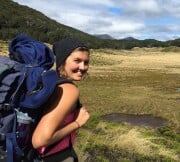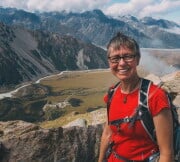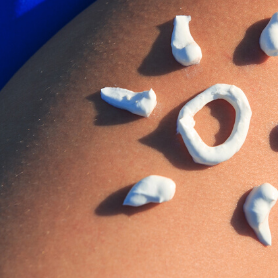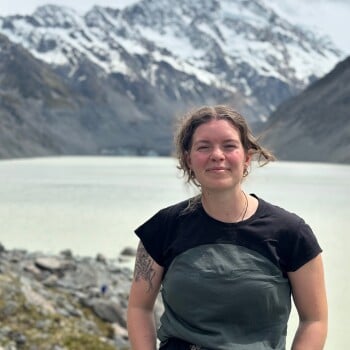- About Us
-
Trips
-
 Kiwi-Style Hiking
Kiwi-Style Hiking
-
 Great Walks
Great Walks
-
 Hiking Tours
Hiking Tours
-
Alpine Hikes
-
Custom Groups
- Huayhuash Trek
- Family Northern Explorer
- Family Southern Explorer
- Lake Waikaremoana Hike
- Women's Custom Tours
- Women's Southern Wilderness
- Coast, Canyons and Mountains
- Coastal Wanderer Custom Tour
- Don't Cross the Ladies
- Secret South Custom Tour
- Tekapo Hike
- West Coast Custom Tour
- World Heritage Custom Tour
-
- Blog
- Shortlist
- About Us
- Trips
- Blog
- Shortlist

Jul 31, 2025
Sometimes you wonder if the weather actually cares what season it is in New Zealand. We have some local knowledge to help you work out the best month for your hiking adventure.
What month should you travel?
Each season does bring different elements to your hiking experience and although climate change is said to be adding another level of unpredictability, it's still the old el nino / la nina weather patterns that hold the power here when they wake from their slumber. The cold and warmth of a season lag the solstice by about a month. December 21st is our longest day, but the warmest time is mid January onwards. Hilariously, we once had a hiking group enjoy a white Christmas in Fiordland National Park. It's like a New Yorker building snowmen in late June. Below are some expectations you should have for the four seasons.
Spring Hiking in New Zealand
North Island weather: 16-20⁰C (60-68⁰F), 90-120mm of rainfall per month / South Island weather: 13-19⁰C (55-66⁰F), 60-100mm of rainfall per month
As the earth's tilt positions New Zealand towards the sun more, the days begin to get a little longer and a little warmer. The country springs to life with a burst of colour from the exotic trees' in the towns and cities. Hard remnant winter snow still glazes the high country - especially on south faces.
Spring is a great time to head out into the hills. Tracks are quieter as the tourist season hasn’t begun just yet. The sun has arrived. But the rivers are a bit cold for swimming in just yet! Parks like Paparoa, Westland, Aspiring and Fiordland that were potentially quite limited and miserable in winter are now way more enjoyable to visit.

September - Although the days are starting to warm up, snow can still be seen on the mountain peaks. Winter sports lovers lap up a last run at the ski fields as the snow starts to melt away. Hard remnant winter snow still glazes the high country - especially on south faces. Trails that go high may still be needing crampons. Avalanches crossing the trails are less likely, especially in the mornings when things are still frozen. The last Sunday in September the clocks spring forward, gracing us with an extra hour of afternoon daylight.
October - We experience warmer but windier days from the west (equinox weather), but noticeably longer days now.
November - The busy Summer season is just around the corner. Schools and businesses aren’t out just yet, so this is a great time to avoid the tourist rush and head out into the hills. The sun melts away the snow in the Southern Alps causing river levels to rise and creating powerful waterfalls which are an impressive sight. It's not unknown for a stream to become uncrossable in the late afternoon due to snow melt.
Summer Hiking in New Zealand
North Island weather: 20-24⁰C (68-75⁰F), 60-100mm of rainfall per month | South Island weather: 19-23⁰C (66-73⁰F), 35-60mm of rainfall per month
The latter half of summer is the warmest time of the year to go trekking in New Zealand (although not by a huge degree). The long summer evenings, particularly in the South Island, makes hiking relaxed and enjoyable; With daylight lasting until close to 10 pm, there is no rush to get there. Life definitely operates at a slower pace in Summer. Once the Christmas rush is over, locals can relax and enjoy warm nights down at the beach with a picnic dinner.

December is a great time to travel to New Zealand. Locals are on the starting blocks for their main holiday (our Chrismas and Summer holiday break fall at the same time), but haven’t escaped the daily grind until after Christmas, so beat them to it while the roads and tracks are quiet. School’s out for the Summer from late December to late January. Universities break up from December through to February and most Kiwis take their annual leave for 2 to 3 weeks from the 26th December.
January and February are usually the warmest months of the year and hence the most popular for getting into the New Zealand wilderness. You are guaranteed some settled weather and you will be sharing these lovely long days with kiwis (of the hiker variety) and that’s a great thing - we are pretty welcoming to overseas folk. It's never as mad or busy as the European Alps in the summer - there are only 5 million of us here in a country the size of the UK (with a quarter of the land area taken up in National Parks). In February, school goes back so the pressure goes off a number of “front country” hiking trails and huts. Note that there are a bunch of bank holidays in January and February that will make huts pretty busy in the weekends - keep an eye out for those.
Our trip pick in Summer is the Ultimate North Island or the Ultimate South Island if you have 15 days up your sleeve.
Autumn Hiking in New Zealand
North Island weather: 17-22⁰C (62-71⁰F), 90-130mm of rainfall per month | South Island weather: 13-19⁰C (55-66⁰F), 60-100mm of rainfall per month
Autumn is fantastic and few people realise how settled the weather is this time of the year. Although the sun is setting earlier, the nights are not too chilly, and Kiwis will be stretching out the use of jandals well into Autumn! In the northwest of the South Island and especially the Northern North Island, it is still warm enough to enjoy swimming (the tropical ocean currents usually are still here). Hiking is great in Autumn and in the countryside (not the wilderness areas as we have evergreen trees) it is the most colourful time of year, the trees are coated in rich gold, red and orange tones throughout the country.

March is as good as February, sun protection and swimwear are a must have. The nights can cool down later in the month so warm layers will keep you comfortable after a day of hiking.
April is when we lose an hour of daylight as the clocks fall back on the first Sunday of the month. However, this is still one of the best months in the outdoors with the most settled weather. Sure, the occasional front rumbles through, and the air is a bit cooler, but you may get a weeks worth of consistent perfect weather. The crisp mornings and bright blue days are a real treat, especially in Central Otago and Hawkes Bay.
By May the first dustings of snow arrive and define the mountain tops. You will generally have the hiking trails to yourself by now, but if you show a little cunning and are flexible you will have a good time. Have some plans for bad weather too though!
Our trip pick in Autumn is the North Island Grand Hikes and South Island Grand Hikes or combine the two islands on the New Zealand Grand Hikes. In Autumn the famous Tongariro Crossing has less foot traffic and less chance of people photobombing your perfect picture of Mt Doom. Queenstown is the best location to end your trip as this is where you will experience the special golden sunsets amongst the Autumn coloured trees.
Winter Hiking in New Zealand
North Island weather: 11-15⁰C (51-59⁰F), 120-150mm of rainfall per month | South Island weather: 7-12⁰C (44-53⁰F), 70-130mm of rainfall per month
Flexibility is the key to great hiking in the winter. Read the forecasts, catch the weather windows and glean some local knowledge. Zip from west to east and back again as necessary just like the locals do. But most of all be prepared - have some good kit and a tent or shelter to wait out those flooded rivers. New Zealand is blessed with a plethora of choices when it comes to hiking so be adaptable and change your destination to match the weather conditions. The lower light is lovely for photographs.

June - the beginning of winter so generally there is less snow. The shorter days can still be warm depending on the el nino / la nina offering. Merino layers and a good windproof jacket are key to comfort during a crisp New Zealand winter. There are some special hiking tracks dotted about the country which reward you with a natural geothermal hot pools to soak in and thaw out your toes.
July - Ski fields hopefully are starting up, so if you are out on the trails you can enjoy the snow-capped mountain vistas all to yourself. If you are hiking unguided, be sure to check the weather conditions before you set off, especially in alpine areas.
August - Congratulate yourself for being here when the mountains look their best and the weather is about to be better again. Consider Nordic skiing or snow shoeing as an alternative to hiking if there is a lot of snow around.
Our trip pick in Winter is the Winter South Island Adventure. If you are new to skiing or snowboarding, now’s your chance to learn on some of the best ski slopes in the world!
Let’s get into the nitty-gritty...
Geography 101 - continental versus oceanic
New Zealand is a long thin land 'floating' in a bathtub of ambient water. In most of New Zealand, where we live, work and play is never that hot or cold because the ocean influences it. We are never far from the sea. Sure, we call it cold, but most Americans and Europeans mock us when they realise how benign it really is here - both in summer and winter. Sure, want to freeze in winter? Head to the alps. Swelter in the summer fug, come to Auckland in February. However, in a global climate sense, benign is the word you are looking for to describe the New Zealand climate. This is why we have tropical-like forests that never lose their leaves in winter.
Day length, although not extremely seasonal, is as much the metric to take account of as temperature and weather. The day length limits what you can achieve in the outdoors. The south in mid-winter has only 9-10 hours of daylight. So take a book for those long nights.
The rules - what rules?
There are plenty of exceptions to the rules in New Zealand's climate. The weather is generally changeable, but it does typically vary from east to west (across the ranges). Sun rain, snow and hail, can happen any time of year and anywhere in this temperate, ocean-controlled climate. While the far north of New Zealand is experiencing equatorial warmth, the south, 1600 km away, maybe shivering in a blast of cold polar air, and occasionally vice-versa, but here are some of the 'rules' anyway.
The rules
Typically, the west is exposed to the moist westerly winds drumming across the Tasman Sea and is famous for its rain, often in summer. The east side is correspondingly dry (caused by the foehn wind or Chinook). However, when the weather flows in from the south in winter, this feature is often reversed with sun on the West Coast and rain in the east (as our Alps flow south-west to north-east). A little-known fact is that Hokitika, on the South Island's 'wet' West Coast has a similar number of sun hours as Christchurch in the east. But as tourists are generally only here in summer, it is easy to think Hokitika is always wet and people are lunatics to live there.
Temperatures in the mid-20s are the norm in the summer months of January and February in both Islands, although the North is humid, where the South is drier. Nights are also usually a bit cooler in the south. Winter snows start arriving from May, bringing daytime maximums of only a few degrees Celsius to many of the southern townships.
We get the odd tropical cyclone spinning down over the North Island too, causing windy and wet conditions.








